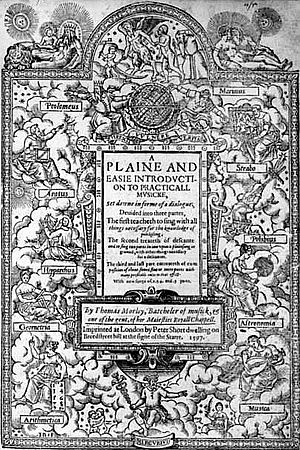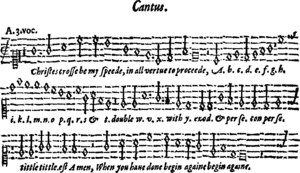Thomas Morley facts for kids
Thomas Morley (born around 1557 – died in October 1602) was a famous English composer, music expert, singer, and organ player during the Renaissance period. The Renaissance was a time of great art and learning in Europe, from the 14th to the 17th century. Morley was a key member of the English Madrigal School. This group of composers wrote a special kind of song called a madrigal.
Morley helped bring the popular Italian madrigal style to England. He made it fit English tastes, leading to a short but amazing period of English madrigal music. He lived in London at the same time as the famous playwright William Shakespeare. Morley was the most well-known composer of non-religious music in Elizabethan England. He and Robert Johnson are the only composers whose music for Shakespeare's poems still exists from that time.
Besides writing music, Morley was also a singer, composer, and organist at St Paul's Cathedral. He also worked in music publishing. From 1598 until he died, he had a special right called a printing patent. This meant he had the only right to print music. He worked with professional music printers like Thomas East to publish many works.
Contents
Early Life and Education
Thomas Morley was born in Norwich, England. His father was a brewer. It is likely that Morley started singing at the local cathedral when he was a boy. By 1583, he became the master of the choirboys there.
People believe Morley moved from Norwich to London before 1574. He became a choirboy at St. Paul's Cathedral. Around this time, he studied music with William Byrd, a very important composer. Morley later called Byrd his teacher in his 1597 book, A Plain and Easie Introduction to Practicall Musicke. Byrd also taught Peter Philips, another composer of that time.
In 1588, Morley earned his bachelor's degree from the University of Oxford. Soon after, he became the organist at St. Paul's in London. Sadly, his young son died in 1589. He and his wife, Susan, had three more children between 1596 and 1600.
Musical Career
In 1588, Nicholas Yonge published a collection of Italian madrigals called Musica transalpina. These songs had English words added to them. This book started a huge trend for writing madrigals in England. Morley found his own musical style around this time. Soon after, he began to publish his own collections of madrigals. He published 11 collections in total.
Morley lived in the same area as Shakespeare for a while. Many people have wondered if they knew each other, but there is no clear proof. Morley wrote a famous song called "It was a lover and his lass." This song was from Shakespeare's play As You Like It. We don't know for sure if this song was used in the play when Shakespeare was alive. However, since the song was published in 1600, it's possible it was used in stage performances.
Morley tried to copy William Byrd's style in some of his early church music. But his biggest impact on music history was through his madrigals. His madrigals are still performed today. They show many different feelings, forms, and techniques compared to other composers of his time. Morley's madrigals are usually light, fast, and easy to sing. A good example is his famous song "Now is the Month of Maying". He took parts of the Italian style that he liked and made them sound English. Other composers of the English Madrigal School, like Thomas Weelkes and John Wilbye, wrote more serious or sad madrigals.
Other Works and Legacy
Besides madrigals, Morley also wrote music for instruments. This included music for keyboard instruments. Some of his keyboard music is found in the Fitzwilliam Virginal Book. He also wrote music for the broken consort. This was a special English group of instruments. It included two viols, a flute, a lute, a cittern, and a bandora. This music was published by William Barley in 1599. The book was called The First Booke of Consort Lessons.
Morley's book, Plaine and Easie Introduction to Practicall Musicke, was published in 1597. It stayed popular for nearly 200 years after he died. This book is still an important source of information today. It tells us about how music was composed and performed in the 1500s.
Thomas Morley was buried in the churchyard of St Botolph Billingsgate. This church was destroyed in the Great Fire of London in 1666 and was never rebuilt. Because of this, his grave is now lost.
Compositions
Here are some of Thomas Morley's musical works:
- April is in my mistress' face
- Arise, get up my deere
- Cease mine eyes
- Come, lovers, follow me
- Come, Sorrow, come
- Crewell you pull away to soone
- Christes crosse
- Do you not know?
- Fair in a morn
- Fantasia for keyboard, Fitzwilliam Virginal Book CXXIV
- Fantasie: Il Doloroso
- Fantasie: Il Grillo
- Fantasie: Il Lamento
- Fantasie: La Caccia
- Fantasie: La Rondinella
- Fantasie: La Sampogna
- Fantasie: La Sirena
- Fantasie: La Tortorella
- Fire Fire My Heart
- Flora wilt thou torment mee
- Fyre and Lightning
- Goe yee my canzonets
- Good Morrow, Fair Ladies of the May
- Harke Alleluia!
- Hould out my hart
- I goe before my darling
- I saw my Lady weeping
- I should for griefe and anguish
- In nets of golden wyers
- It was a lover and his lass
- Joy, joy doth so arise
- Joyne hands
- La Caccia "The Chase"
- La Girandola
- Ladie, those eies
- Lady if I through griefe
- Leave now mine eyes
- Lo hear another love
- Love learns by laughing
- Miraculous loves wounding
- Mistress mine
- My bonny lass she smileth
- Nolo mortem peccatoris
- Now is the month of maying
- O Mistresse mine
- O thou that art so cruell
- A painted tale
- Say deere, will you not have me?
- See, see, my own sweet jewel
- Shepard's Rejoice
- Sing we and chant it
- Sleep, slumb'ring eyes
- Sweet nymph
- Thirsis and Milla
- Those dainty daffadillies
- Though Philomela lost her love Oxford Book of English Madrigals
- 'Tis the time of Yuletide Glee
- Good morrow, Fayre Ladies of the May
- What is it that this dark night
- What ayles my darling?
- When loe by break of morning
- Will you buy a fine dog?
- With my love my life was nestled
Sacred Music
- The Burial Service
- De profundis clamavi
- Domine, dominus noster
- Domine, non est exultarem cor meum
- Eheu sustulerunt domine
- The First Service
- How long wilt thou forget me?
- O amica mea
See also
 In Spanish: Thomas Morley para niños
In Spanish: Thomas Morley para niños
- The Triumphs of Oriana edited by Morley, published in 1601



